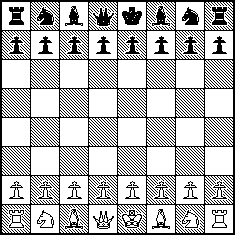The rules of chess
Introduction
Chess is a game, played by two players. One player plays with the white pieces, and the other player plays with the black pieces. Each player has sixteen pieces in the beginning of the game: one king, one queen, two rooks, two bishops, two knights, and eight pawns.The game is played on a chess board, consisting of 64 squares: eight rows and eight columns. The squares are alternately light (white) and dark colored. The board must be laid down such that there is a black square in the lower left corner. To facilitate notation of moves, all squares are given a name. From the view of the white player, the rows are numbered 1, 2, 3, 4, 5, 6, 7, 8; the lowest row has number 1, and the upper row has number 8. The columns are named, from left to right, a, b, c, d, e, f, g, h. A square gets a name, consisting of the combination of its column letter and row number, e.g., the square in the lower left corner (for white) is a1.

Alternately, the players make a move, starting with the white player (the player that plays with the white pieces.) A move consists of moving one of the pieces of the player to a different square, following the rules of movement for that piece - there is one special exception, named castling, where players move two pieces simultaneously.
A player can take a piece of the opponent by moving one of his own pieces to the square that contains a piece of the opponent. The opponents piece then is removed from the board, and out of play for the rest of the game. (Taking is not compulsory.)
At the start of the game, the position of the pieces is as follows.

Thus, at the second row, there are eight white pawns, at the seventh row, there are eight black pawns. At the first row, from left to right, we have a: rook, knight, bishop, queen, king, bishop, knight, and rook. Note that the queens start of squares of their own color, with a dark square in each players left hand corner.
Next: Movement of the pieces (1)
Written by Hans Bodlaender.
WWW page created: September 23, 1997. Last modified: November 23, 1998.